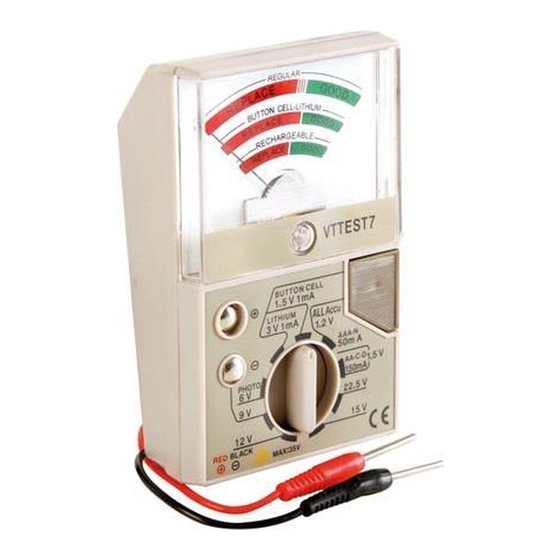
Inhaltsverzeichnis
Werbung
Verfügbare Sprachen
Verfügbare Sprachen
Quicklinks
1. Introduction
To all residents of the European Union
Important environmental information about this product
This symbol on the device or the package indicates that disposal of the device after its lifecycle could harm
the environment.
Do not dispose of the unit (or batteries) as unsorted municipal waste; it should be taken to a specialised
company for recycling.
This device should be returned to your distributor or to a local recycling service.
Respect the local environmental rules.
If in doubt, contact your local waste disposal authorities.
Your new VTTEST7 is a sensitive and accurate device for testing batteries under charge. You can test standard zinc
carbon, alkaline, mercury, silver oxide, lithium and nickel cadmium batteries.
2. Operation
a) Select the correct battery type and voltage with the recessed range switch. Examples:
- move the range selector to the position labelled "1.5V AA-C-D" if you wish to test AA-, C- or D-batteries of 1.5V.
- select the "9V"-position to test rectangular 9V-batteries.
- select the "BUTTON CELL 1.5V"-position to test mercury, silver or alkaline button cells.
- select the "LITHIUM 3V"-position for lithium button cells.
- select the "1.5V AA-C-D"-position to test nickel cadmium batteries of 1.25V and read the value on the lowest of
the three scales on the analogue display.
The value indicated on the meter is the load current drain placed on the battery during the check.
CAUTION: Selecting the wrong range will yield inaccurate results. You may also damage the device in the process.
b) Place the red probe tip (+) against the positive (+) battery terminal and the black probe tip (-) against the negative (-)
battery terminal.
CAUTION : Mind the polarity indications when testing your batteries!
Select the correct range (see above). Use the following procedure to test your batteries:
- Place the battery's negative (-) terminal against the VTTEST7's negative (-) contact and touch the battery's
positive (+) terminal with the red probe tip (+).
- In order to test rectangular 9V-batteries : place the battery's negative (-) terminal against the VTTEST7's negative
(-) contact and place the battery's positive (+) terminal against the VTTEST7's positive (+) contact.
- In order to test button cell batteries: insert the battery in the slot on the side of the device. Make sure the negative
(-) pole is facing up and press the brown switch on the front panel.
CAUTION : Observe the following safety prescriptions in order to avoid all damage to the button cell being tested:
- Do not push the brown switch when using the probe tips to test a button cell.
- Do not allow the red probe tip (+) to contact the black probe tip (-) when using the 9V-contacts to test button cells.
c) Read the analogue display to determine the condition of the battery.
- Use the upper scale ("REGULAR") for measuring regular zinc carbon and alkaline batteries.
- Use the centre scale ("BUTTON CELL - LITHIUM") for measuring mercury, silver oxide, alkaline and lithium
button cells.
- Use the lower scale ("NICKEL CADMIUM") for measuring rechargeable nickel cadmium batteries.
VTTEST7
VTTEST7 - BATTERY TESTER
1
VELLEMAN
Werbung
Inhaltsverzeichnis

Inhaltszusammenfassung für Velleman VTTEST7
- Seite 1 Respect the local environmental rules. If in doubt, contact your local waste disposal authorities. Your new VTTEST7 is a sensitive and accurate device for testing batteries under charge. You can test standard zinc carbon, alkaline, mercury, silver oxide, lithium and nickel cadmium batteries.
-
Seite 2: Specifications
"REGULAR" scale. Note that the device can test most battery types. However, you should not use the VTTEST7 to test motorcycle or car batteries, lead batteries and 6V- and batteries for 12V-lanterns. - Seite 3 "REGULAR" schaal. Merk op dat de VTTEST7 de meeste types batterijen kan testen. U mag het toestel echter niet gebruiken om volgende types te testen: 6V- en 12V-batterijen voor zaklantaarns, loodbatterijen of batterijen voor auto's en motoren.
- Seite 4 • Bewaar het toestel niet in een stoffige of vuile omgeving: zo vermijdt u vroegtijdige slijtage van de bewegende onderdelen. • Gebruik geen solventen of schuurmiddelen om de VTTEST7 te reinigen. Gebruik een zachte doek die bevochtigd is met een milde oplossing van water en zeep.
-
Seite 5: Opération
Sélectionnez la plage correcte (voir ci-dessus) et testez vos piles de la façon suivante : - Touchez le contact négatif (-) du VTTEST7 avec la broche négative (-) de la pile et contactez la broche positive (+) de la pile avec la pointe de touche rouge (+). -
Seite 6: Spécifications
• Le VTTEST7 ne peut pas être stocké dans un environnement sale ou poussiéreux. Un tel environnement mènerait à une usure prématurée des pièces mobiles. • Il est interdit de nettoyer le VTTEST7 avec des solvants ou des abrasifs. Employez un chiffon doux et une solution douce de savon et d'eau. - Seite 7 Wählen Sie den korrekten Bereich (siehe oben). Befolgen Sie diese Vorgehensweise um Ihre Batterien zu prüfen: - Bringen Sie die negative Batterieklemme (-) gegen den negativen Kontakt des VTTEST7 (-) und berühren Sie die positive Batterieklemme (+) mit der roten Prüfspitze (+).
-
Seite 8: Technische Daten
• Verwenden Sie keine Lösungs- oder Schleifmittel. Reinigen Sie das Gerät mit einem sanften Tuch mit Wasser und einer milden Seifenlösung. • Wenden Sie sich bei Fehlfunktion an qualifizierte Fachleute. Öffnen Sie nie selbst das Gerät, denn der VTTEST7 hat keine vom Benutzer zu reparierenden Teile.











